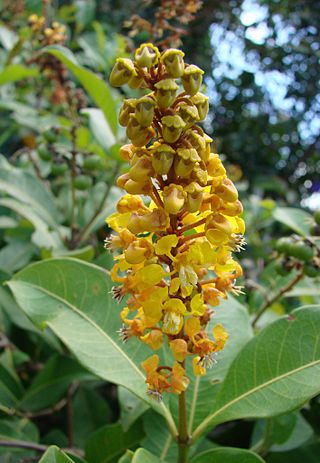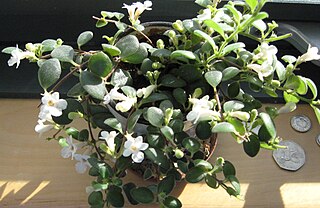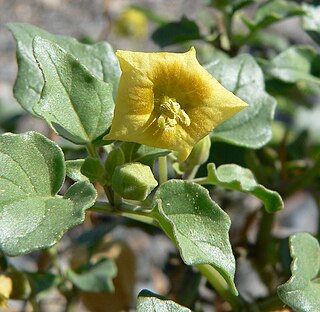
Byrsonima crassifolia is a species of flowering plant in the family Malpighiaceae, native to tropical America. Common names used in English include nance, maricao cimun, craboo, and golden spoon. In Jamaica it is called hogberry.

Ulmus crassifoliaNutt., the Texas cedar elm or simply cedar elm, is a deciduous tree native to south-central North America, mainly in southern and eastern Texas, southern Oklahoma, Arkansas, and Louisiana, with small populations in western Mississippi, southwest Tennessee, and north-central Florida; it also occurs in northeastern Mexico. It is the most common elm tree in Texas. The tree typically grows well in flat valley bottom areas referred to as cedar elm flats. The common name cedar elm is derived from the trees' association with juniper trees, locally known as cedars.

Byrsonima is one of about 75 genera in the Malpighiaceae, a family of flowering plants in the order Malpighiales. In particular in American English, they are known as locustberries. Another widely seen common name is serrets or serrettes.
The cedar elm cultivar Ulmus crassifolia 'Brazos Rim' was cloned from a tree growing at the Sunshine Nursery, Clinton, Oklahoma.

Hosackia crassifolia, synonym Lotus crassifolius, is a species of legume found in the western United States. It is known by the common names big deervetch and broad-leafed lotus.

Arctostaphylos glandulosa, with the common name Eastwood's manzanita, is a species of manzanita.

Maerua crassifolia is a species of plant in the Capparaceae family. It is native to Africa, tropical Arabia, and Israel, but is disappearing from Egypt. Foliage from this plant is used as fodder for animals, especially camels, during the dry season in parts of Africa.

Scaevola crassifolia is a shrub in the family Goodeniaceae, native to Western Australia and South Australia. Common names include cushion fanflower, thick-leaved fanflower and thick-leaved scaevola. It grows up to 1.5 metres high and 3 metres wide and produces white, blue or pale purple flowers from July to February in its native range.

Codonanthe is a genus of mainly epiphytic plants in the family Gesneriaceae, endemic to the Atlantic Forest of Brazil. The botanical name comes from the Ancient Greek for 'bellflower'. They have white or pale pink flowers and somewhat fleshy leaves. In 2013, the genus was reduced in size when more than half of the species were transferred to Codonanthopsis. They can be grown as houseplants, particularly in hanging baskets. Artificial crosses with Nematanthus hybrids have produced the hybrid genus × Codonatanthus.

Physalis crassifolia is a species of flowering plant in the nightshade family known by the common names yellow nightshade groundcherry and thick-leaf ground-cherry. It is native to the southwestern United States and northern Mexico, where it can be found in rocky, dry desert and mountain habitat. This is a perennial herb producing a ridged, angular, branching stem approaching 80 cm long, taking a clumped, matted, or erect form. The fleshy oval leaves are 1 to 3 cm long and have smooth, wavy, or bluntly toothed edges. The herbage is glandular and coated in short hairs. The yellow flowers growing from the leaf axils are widely bell-shaped, vaguely five-lobed, and around 2 cm wide. The star-shaped calyx of sepals at the base of the flower enlarges as the fruit develops, becoming an inflated, angled lanternlike structure about 2 cm long, which contains the berry.

Bergenia crassifolia is a species of flowering plant of the genus Bergenia in the family Saxifragaceae. Common names for the species include heart-leaved bergenia, heartleaf bergenia, leather bergenia, winter-blooming bergenia, elephant-ears, elephant's ears, Korean elephant-ear, badan, pigsqueak, Siberian tea, and Mongolian tea.

Fritillaria crassifolia is a Middle Eastern species of bulb-forming flowering plant in the lily family Liliaceae, native to Iran, Iraq, Turkey, Syria, and Lebanon.

Quercus crassifolia is a species of oak. It is widespread in Mexico from Sonora and Chihuahua to Veracruz and Chiapas. It has also been found in Guatemala.
Grevillea crassifolia is a species of flowering plant in the family Proteaceae and is endemic to the south-west of Western Australia. It is an open shrub with often thick, elliptic to oblong leaves and red flowers.
An ant garden is a mutualistic interaction between certain species of arboreal ants and various epiphytic plants. It is a structure made in the tree canopy by the ants that is filled with debris and other organic matter in which epiphytes grow. The ants benefit from this arrangement by having a stable framework on which to build their nest while the plants benefit by obtaining nutrients from the soil and from the moisture retained there.

Codonanthopsis is a genus of flowering plants in the family Gesneriaceae. Its native range is from southern Mexico through tropical America to Bolivia and most of Brazil. Codonanthopsis species are generally trailing epiphytes with pale flowers. Most have a mutualistic relationship with tree-living ants: the plants provide the ants with food, including nectar, and give their nests structure and support, while the ants disperse the plants' seeds. The genus was considerably expanded in 2013 when species were transferred from Codonanthe. Some Codonanthopsis species are cultivated as houseplants, when they may be grown in hanging baskets.

Epacris crassifolia is a species of flowering plant in the heath family Ericaceae and is endemic to south-eastern New South Wales, Australia. It is a low-lying shrub with elliptic to egg-shaped leaves with the lower end towards the base, and tube-shaped, white or cream-coloured flowers clustered near the ends of the branches.
Codonanthopsis calcarata is a species of flowering plant in the family Gesneriaceae. This species is native to Bolivia, Brazil North, Brazil West-Central, Colombia, French Guiana, Guyana, Suriname, and Venezuela. Codonanthopsis calcarata is an epiphyte, and mainly grows in wet tropical biomes. Codonanthopsis calcarata was first published in 2013.
Codonanthopsis caribaea is a species of flowering plant in the family Gesneriaceae. This species is native to Guadeloupe to North Venezuela, and is a epiphyte and mainly grows in wet tropical biomes. Codonanthopsis caribaea, along with other species in its genus, was first published in 2013.
Codonanthopsis erubescens is a species of flowering plant in the family Gesneriaceae. This species is native to Ecuador and mainly grows in wet tropical biomes. Codonanthopsis erubescens was first published in 2013.














